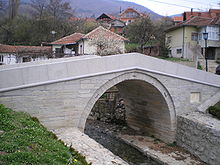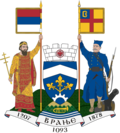Vranje
|
Врање Vranje |
||||
|
||||
| Basic data | ||||
|---|---|---|---|---|
| State : | Serbia | |||
| Okrug : | Pčinja | |||
| Coordinates : | 42 ° 33 ' N , 21 ° 54' E | |||
| Height : | 485 m. i. J. | |||
| Area : | 860 km² | |||
| Residents : | 56,199 (2002) | |||
| Agglomeration : | 87,288 (2002) | |||
| Population density : | 65 inhabitants per km² | |||
| Telephone code : | (+381) (0) 17th | |||
| Postal code : | 17501 | |||
| License plate : | VR | |||
| Structure and administration (status: 2007) | ||||
| Community type: | city | |||
| Mayor : | Miroljub Stojčić ( SPS ) | |||
| Website : | ||||
Vranje ( German outdated Wragl ; Serbian - Cyrillic Врање ) is a city in southeast Serbia . It is the capital of the Serbian district of Pčinja .
population
The Opština Vranje has 87,288 inhabitants (as of 2002), 55,055 of them were in the city itself. According to the 2002 census, over 93% of the residents consider themselves Serbs , the remaining 7% are mainly Roma .
geography
Vranje is located about 350 km south of Belgrade at an altitude of 480 m in the Južna Morava valley and covers an area of 859.9 km². The highest point of Opština Vranje is the summit of Besna kobila (1,922 m). The climate is temperate-continental.
Etymology of the name
The name is probably related to the old Serbian word vran for black, see also vrana , the crow , as an example . In addition to the city of Vranje, there was also the landscape of Vranja in the Middle Ages, although it is not clear whether the city served as the name giver for the landscape or the landscape as the name giver for the city. Translated into German, Vranje could be referred to as the black , the landscape due to its dense forests and ravines as the dark or the black land.
history
It is not known when exactly the village, which is now called Vranje, came into being; in any case, it was an important point on the politically and economically strategically important Morava-Vardar furrow .
Vranje is mentioned for the first time in the Alexiad of the Byzantine princess Anna Komnena . According to her, Vranje then belonged to Byzantium and was briefly conquered by the Serbian Župan Vukan around 1093 . Before that the area belonged alternately to Byzantium and Bulgaria .
In 1190 Stefan Nemanja was able to take Vranje in an alliance with Hungary , but had to withdraw again around 1191. After the alliance with Hungary fell apart, Nemanja turned to Byzantium, from whom he was given some of his earlier conquests such as Prizren and Vranje. For a short time Vranje fell to the second Bulgarian empire , and then from 1207 permanently belonged to the Serbian state of the Nemanjids .
After the disintegration of Stefan Dušan 's empire , Vranje was ruled by the partial prince Vlatko. He was followed by "Caesar" Uglješa (not to be confused with Jovan Uglješa ), who recognized the suzerainty of Stefan Lazarević around 1402 . After Uglješa's death, Vranje fell under the direct rule of Stefan's successor Đurađ Branković . Constantine the philosopher spent the last years of his life in Vranje .
In 1455 Vranje was conquered by the Ottomans and remained Ottoman until 1878. The local Serbian aristocrat Nikola Skobaljić then led an ultimately unsuccessful rebellion against the Ottomans with his lightly mounted troops.
An Albanian population group lived in the city during the Ottoman period, but they were expelled to the south and south-west when the area was conquered by the Serbian Empire.
In the 19th century, Vranje was to be claimed by both Serbia and Bulgaria. In 1878 Serbian troops occupied Vranje and incorporated it into the newly independent principality of Serbia . During World War I and World War II , Vranje was briefly occupied by Bulgarian troops.
Attractions

- The medieval castle ruin Markovo Kale was built according to the legend by Marko Kraljević .
- The White Bridge or Bridge of Love , according to tradition, founded around 1844 by a rich Turkish woman in memory of the tragic love of her daughter Ayşe for the Serbian shepherd boy Stojan (Ayşe is said to have been killed by her father when he wanted to shoot Stojan, whereupon Stojan himself took life). According to a persistent legend, the dedication carved in Turkish on a plaque on the bridge reads: Cursed should be everyone who wants to separate what is bound by love. In fact, the text does not speak of love or separation.
- the hamam , the Turkish bath, now a museum
- the Konak des Pasha and the Haremluk , once the seat of the Ottoman Pasha, today the city museum
sons and daughters of the town
- Borisav "Bora" Stanković (1876–1927), Serbian writer
- Justin Popović (1894–1979), Orthodox monk and theologian
- Josip Kuže (1952–2013), Croatian football player and coach


